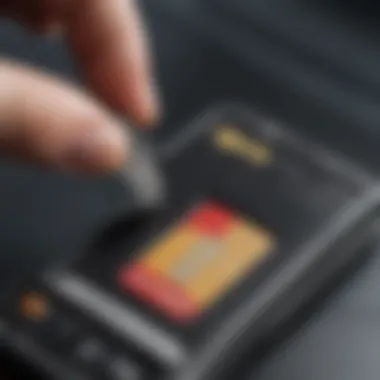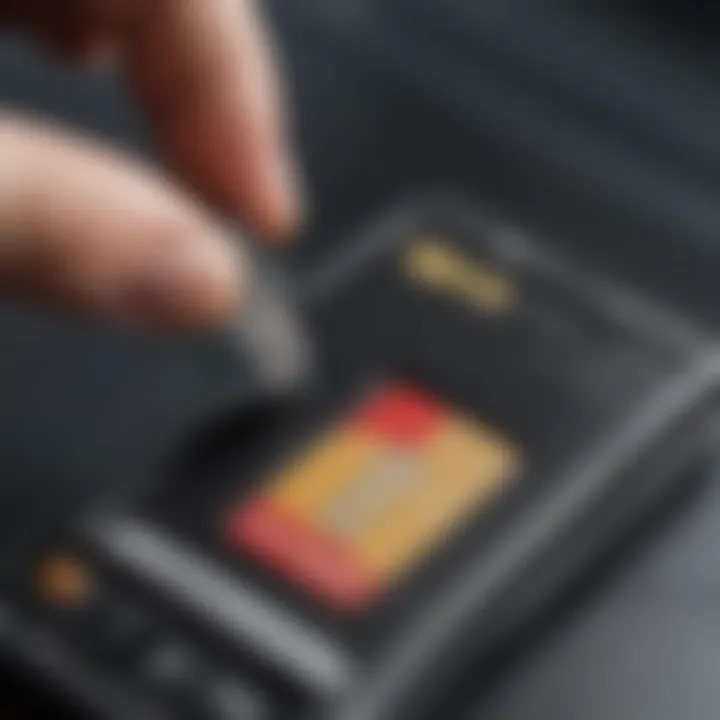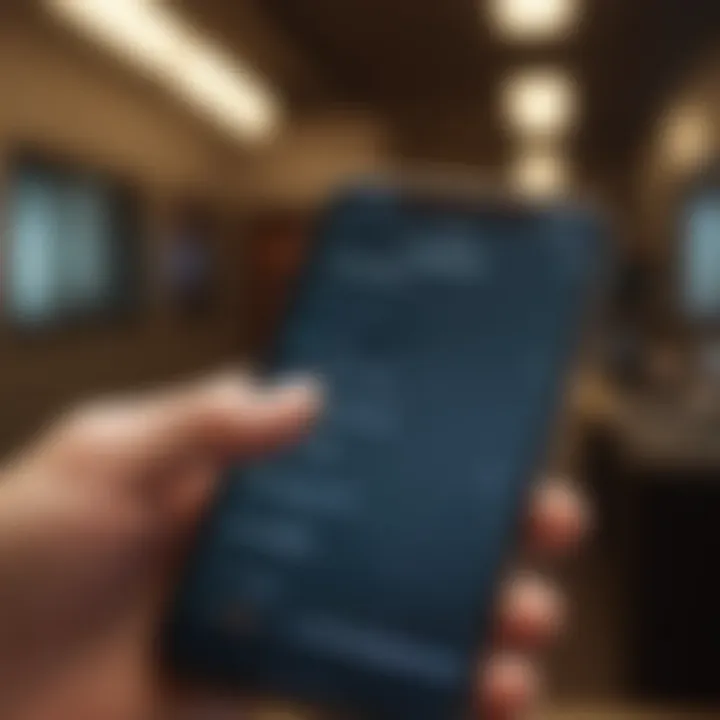How to Determine if Your Phone is Unlocked


Intro
In today's mobile-centric world, knowing whether your phone is unlocked is essential for making informed decisions regarding your telecommunications options. An unlocked phone can be used with various carriers and different SIM cards, providing flexibility unheard of with locked devices. This guide will explore how to determine your phone's unlocked status, the implications of using locked versus unlocked devices, and the process of unlocking your phone if it is indeed locked.
Overview of Device Unlocking
Unlocking a phone refers to the removal of restrictions imposed by the carrier, allowing the device to be used on any compatible network. This action expands the user's choices in selecting carriers and plans that may better suit their needs.
Key Features of Unlocked Phones
- Carrier Flexibility: Users can switch between different carriers easily.
- SIM Card Compatibility: Unlocked phones can use SIM cards from various providers worldwide.
- Resale Value: Unlocked devices often have a higher resale value due to their versatility.
Purpose and Benefits
The primary purpose of unlocking your phone is to allow freedom in choosing carriers, especially when traveling internationally. Benefits include cost savings and enhanced control over your mobile experience.
An unlocked phone offers greater freedom and potential savings.
Methods to Determine if Your Phone is Unlocked
Several methods can help you check if your phone is unlocked. Each method varies in complexity and reliability.
Using Your Current SIM Card
One of the simplest ways is to insert a SIM card from a different carrier. If you can make calls or send texts, your phone is likely unlocked.
Checking Mobile Settings
Many smartphones have a setting that indicates the carrier status. For example, on iPhones, you can find this information under Settings > Cellular > Cellular Data Options.
Contacting Your Carrier
Your carrier can provide clarity on your phone’s status. They may require your device’s IMEI number to assist you effectively.
Implications of Locked vs.
Unlocked Phones
The distinction between locked and unlocked phones is significant.
Locked Phones
Locked devices restrict users to the original carrier’s services only. Some disadvantages include:
- Limited service options
- Potential high fees for out-of-network usage
- Challenges when traveling abroad
Unlocked Phones
With unlocked phones, advantages include:
- Easier transition between carriers
- Better prices on service plans
- Access to international SIM cards without restrictions
Steps for Unlocking a Phone
If you find that your phone is locked and wish to unlock it, follow these steps:
- Check Your Eligibility: Not all devices can be unlocked. Confirm your phone meets the requirements set by your carrier.
- Request Unlocking: Contact your carrier to request the unlock code or procedure. Some may allow this action via their website.
- Input Unlock Code: If provided a code, follow the instructions carefully to unlock your phone.
- Test with Another SIM Card: Confirm that the phone is unlocked by inserting a different SIM card.
Common Mistakes to Avoid
- Failing to confirm eligibility prior to requesting an unlock.
- Not understanding the unlocking process specific to your carrier.
This guide aims to empower you with the knowledge needed to make the best mobile choices for your distinct needs. By understanding how to check and unlock your phone, you can enhance your mobile experience significantly.
Prelude to Phone Unlocking


Phone unlocking is a significant aspect of mobile technology that affects users in multiple ways. Understanding what it means for a phone to be unlocked is essential for anyone who wants flexibility in how they use their device. This guide explores the nuances of phone unlocking, emphasizing its relevance in today’s mobile landscape.
Definition of Unlocked Phones
An unlocked phone is a device that is not tied to a specific carrier and can accept SIM cards from different providers. This means that users can choose their carrier based on preferences such as cost and service quality. Unlike locked phones, which are bound to a single network, unlocked phones allow for freedom in carrier selection. This is particularly useful in regions where various providers offer different advantages.
The process of unlocking can happen at various stages of a phone's life cycle. Some phones come factory unlocked, meaning they are ready to use with any carrier right out of the box. Others may be locked for a certain period due to contractual obligations or discounts provided by the carrier at the time of purchase.
Importance of Unlocking Status
The unlocking status of a phone carries significant implications for consumers. An unlocked phone offers greater freedom and flexibility when it comes to carrier choices, as it unties the user from contracts and limitations imposed by a particular service provider. Users can switch carriers to take advantage of better plans, promotions, or improved service when their current provider fails to meet expectations.
In financial terms, using an unlocked device may lead to cost savings. Users can shop around for more affordable data and voice plans, which is beneficial in a competitive market. For frequent travelers, having an unlocked phone holds additional importance as it allows them to use local SIM cards, thereby avoiding exorbitant roaming fees.
Unlocking translates not just to equipment freedom, but to navigating a landscape of cost efficiency and user empowerment.
Furthermore, knowing whether a phone is unlocked plays a vital role when it comes to resale. Unlocked devices typically hold higher resale value, as potential buyers appreciate the flexibility they provide. In summary, understanding the unlocking status of a phone is crucial for maximizing its potential and ensuring optimal user experience.
Methods to Check Phone Unlocked Status
Understanding the unlocked status of your phone is essential. It determines your flexibility in changing carriers and can impact your overall experience with mobile services. Knowing if your phone is unlocked enables you to use different SIM cards and take advantage of competitive pricing. Here, we discuss practical methods to verify your phone's unlocked status. Each method has its own benefits, and employing the right one can lead to more informed decisions regarding your mobile service options.
Using carrier compatibility checks
Carrier compatibility checks are a straightforward way to determine if a phone is unlocked. Many mobile service providers offer online tools that allow you to input your phone's IMEI number. The tool then indicates whether the device works on their network and if it's unlocked. This can also help you find out if your phone is compatible with other carriers, which is useful if you consider switching.
- Visit your carrier's website.
- Locate the section for device compatibility.
- Enter your phone's IMEI number.
- Review the results for locked or unlocked status.
Using this method is beneficial because it gives a clear and quick answer. It also helps you to be aware of alternatives if your current service does not meet your needs.
SIM card tests
Performing a SIM card test is another effective mechanism to ascertain a phone’s unlocked status. This is done by inserting a SIM card from a different carrier into your phone. If your phone connects successfully and you can make calls or use data, it is likely unlocked.
Here’s how you can conduct a SIM card test:
- Power off your phone.
- Replace the existing SIM card with one from a different carrier.
- Turn the phone back on.
- Check for network connectivity.
This method is particularly effective as it provides immediate feedback about your phone's status. It allows you to explore diverse network options, enhancing your overall mobile experience.
Device settings inspection
Inspecting the device settings is a reliable way to check for unlocked status. Often, unlocked phones will not have carrier-specific settings or restrictions. By navigating to the settings, especially in the Network or About sections, you can search for indicators of locked status. You may look for options that are typically only present in unlocked devices:
- The absence of a carrier name in the network options.
- Options to change APN settings freely.
To inspect device settings:
- Open your phone settings.
- Go to the Network options.
- Look for any restrictions or carrier information.
This inspection method may require some familiarity with the settings, yet it can provide valuable insight into your phone’s locked or unlocked status.
Official manufacturer tools
Many manufacturers provide tools specifically designed to check the unlock status of their phones. For instance, Apple and Samsung have web-based services that verify whether a device is locked. These tools typically require your phone's IMEI number.
To use these official manufacturer tools:
- Visit the manufacturer’s support website.
- Look for unlock status check features.
- Enter your IMEI number as prompted.
- Follow the instructions to receive your status.
Using manufacturer tools ensures that the information you receive is authoritative and accurate. This method can save you from misleading results and offers peace of mind regarding your phone’s capabilities.
Remember: Always keep records of your phone's IMEI number, as it is crucial for all verification processes.
Implications of Locked vs.


Unlocked Phones
Understanding the differences between locked and unlocked phones is vital for users today. The implications can significantly affect how one uses their device, interacts with mobile services, and manages costs. It comes down to flexibility, financial awareness, and usability, especially for those looking to travel abroad or switch carriers.
Flexibility with carriers
An unlocked phone offers a distinct advantage in carrier flexibility. Consumers can easily switch between different service providers without the constraints imposed by carrier-locked devices. This becomes essential for individuals who may want to take advantage of better service plans or promotions.
With a locked phone, you are often tied to a single carrier for the duration of your contract. If you frequently change locations or want to explore competitive service options, an unlocked phone allows you this freedom.
- Choosing plans: Moving to an unlocked phone lets users choose from a variety of plans that align with their financial goals.
- Service Provider Switch: It is simpler to switch carriers if you have an unlocked device, therefore reducing dependence on a single provider.
Cost considerations
Cost is a major factor in deciding between locked and unlocked phones. Locked phones are often subsidized by the carrier, meaning the upfront cost is lower. However, the long-term costs can be higher due to service contracts and limited options. An unlocked phone may require a larger initial investment, but the potential savings gained through better deals and the lack of contracts can make it worthwhile.
Some points to consider include:
- Monthly Fees: Unlocked phones typically allow users to choose from more flexible plans, which can be significantly less expensive over time.
- Resale Value: Unlocked phones tend to have a higher resale value compared to their locked counterparts. This can offset the initial price.
Traveling and international use
When traveling, an unlocked phone can be unbelievably beneficial. It allows for seamless access to local SIM cards in different countries, eliminating the need for expensive international roaming fees. With an unlocked device, you can insert a local SIM card upon arrival, reducing costs significantly during travel.
Travelers might find the following advantages:
- Local communication: Access to local networks means improved connectivity and cheaper rates for calls and data while abroad.
- Choice of services: You can select the best local carrier, which might offer superior coverage in certain areas compared to your home carrier.
Opting for an unlocked phone not only promotes freedom in usage but also eases the burden of costs and connectivity while traveling.
In summary, the implications of locked versus unlocked phones span several critical aspects of mobile use. Flexibility with carriers, cost considerations, and advantages during international travels make understanding these differences essential for consumers.
Steps to Unlock Your Phone
Understanding how to unlock your phone is an essential part of managing your mobile device. Unlocking a phone allows users to switch carriers, avoid restrictive contracts, and use international SIM cards when traveling. Each unlocking method has its own pros and cons, so it is crucial to know your options.
Contacting your carrier
The first step in unlocking a phone typically involves reaching out to your carrier. Most carriers have specific policies regarding unlocking, which can vary by the type of phone and the duration of your contract. When contacting your carrier, ensure you have relevant information ready, including your account number and the IMEI number of your device. This number is unique to your phone and can usually be found in the settings or by dialing *#06#.
When speaking with customer service, be clear about your request to unlock your phone. Inquire about the specific requirements for unlocking, such as any outstanding payments or obligations on your account. It’s essential to understand their terms and follow them closely. Although it might take time, this is often the most straightforward and compliant approach to unlocking your device.
Using third-party unlocking services
For those who find that contacting the carrier is not a viable option, third-party unlocking services are available. These services specialize in unlocking phones from various manufacturers and carriers. Before choosing a third-party service, it is important to conduct thorough research. Look for reviews on platforms like Reddit or forums dedicated to technology discussions. Ensure that the service has a solid reputation and guarantees a successful unlocking.
Also, be mindful of the potential risks associated with using these services. Ensure that you understand any fees involved and look out for any hidden charges. It is wise to check if they provide a satisfaction guarantee and learn about their privacy policies regarding your personal data. While these services can be convenient, they require careful consideration.
Software unlocking options
Software unlocking options can also be a method to consider. This process involves downloading specific applications or tools that assist in unlocking a device. However, this method can vary significantly in effectiveness depending on the phone model.
Before proceeding with software unlocking, it is crucial to understand that this may void your warranty or expose your device to vulnerabilities. Users should ensure they download software from reputable sources to minimize risks. Various online guides can provide clear instructions for specific device models, but caution is always advised.
Ultimately, weigh the benefits against the risks when considering software unlocking. Some users find this method convenient while others prefer the security of official pathways.
Unlocking your phone can save you from being tied to a single carrier, enhancing mobility and flexibility.
Potential Risks of Unlocking Devices
Unlocking a mobile phone can provide significant flexibility and freedom of choice regarding service providers and SIM cards. However, it comes with certain risks that deserve careful consideration. Understanding these risks is essential to making informed decisions. This section discusses the main risks associated with unlocking devices, including warranty implications, security vulnerabilities, and legal considerations.
Warranty implications
Many consumers are unaware that unlocking their devices may void the warranty offered by the manufacturer or the carrier. This is a key factor to consider. Each warranty comes with specific terms and conditions, and often, unlocking a phone is not covered under those terms. Once the device is unlocked, any issues arising from hardware or software malfunctions may not be addressed under warranty.


Before initiating the unlocking process, check the warranty conditions carefully. If the phone is still under warranty, you might want to think twice or explore other options that won't affect your warranty status. It's sometimes advisable to reach out directly to your carrier or manufacturer. This may provide clarity on their stance regarding unlocked devices.
Security vulnerabilities
Unlocking a phone may also introduce security vulnerabilities. Some unlocking methods, especially those that involve third-party services or apps, could expose your device to potential risks. For instance, using unauthorized software could lead to malware infections or data breaches. The more access non-official applications have to your device, the more at risk it becomes.
In addition, once your phone is unlocked, it's important to keep security features up to date. You should maintain the latest software updates to protect against emerging threats. Consider using reputable antivirus software as an extra layer of defense. This can help in mitigating risks that can arise after unlocking your phone.
Legal considerations
Finally, unlocking a device can cause legal complications. The legality of unlocking phones varies by region, and laws may change over time. While in many areas, unlocking is legal as consumers retain ownership of their devices, certain jurisdictions might have stricter regulations. Users can potentially face consequences if they unlock a phone against the policy of the carrier or without following proper legal procedures.
Research the laws applicable in your area before proceeding with unlocking. Knowing your rights and responsibilities ensures compliance with local regulations. If there are uncertainties, consulting with a legal expert in telecommunications might provide additional peace of mind.
In summary, while unlocking provides advantages in flexibility and carrier choice, it also presents risks that require careful navigation. Weighing these risks against the benefits can help in making a knowledgeable decision.
Common Myths about Phone Unlocking
Understanding common myths about phone unlocking is essential for consumers navigating mobile technology. Misconceptions can lead to confusion, causing individuals to make uninformed decisions. It is important to clarify these misunderstandings to empower users with accurate information regarding their devices and their unlocking status.
Unlocking voids the warranty
One prevalent myth is the belief that unlocking a phone automatically voids its warranty. This notion stems from the general fear associated with tampering with a device. However, the truth is nuanced. While certain unlocking methods might affect warranty coverage, many carriers and manufacturers allow unlocking without penalty, given it adheres to their specific terms. For example, if you unlock your device through official channels provided by your carrier, your warranty remains intact.
Considerations include:
- Identifying the unlocking method: Official unlocking usually keeps warranty coverage.
- Understanding terms of service: Review the contract and warranty terms before proceeding with unlocking.
- Consulting the carrier: It's prudent to contact your carrier to clarify their specific policy on unlocking a device.
Caution is still advised because unauthorized methods can impact device performance or future support. However, it is not accurate to claim that all types of unlocking void warranties.
All phones can be unlocked easily
Another misconception is that all phones can be unlocked with ease. While many devices can be unlocked, the actual process varies significantly across manufacturers and carriers. Some phones have software or hardware limitations that prevent unlocking. Moreover, depending on the carrier’s policy, unlocking may not be straightforward or even possible in some instances.
Key points to consider:
- Not all phones are compatible: Different models and operating systems might have unique restrictions.
- Carrier policies vary: Some carriers impose stricter conditions than others regarding unlocking devices.
- Technical skills may be required: Although some users can unlock their phones, others may need assistance from professionals.
Therefore, it is misleading to suggest that every phone can be unlocked effortlessly. Potential users should conduct research based on their specific model and application to understand the reality behind unlocking their device.
Research is the key to making informed decisions when it comes to phone unlocking. Knowledge empowers consumers to avoid pitfalls and explore their options effectively.
Comparison of Locked and Unlocked Phones
Understanding the difference between locked and unlocked phones plays a vital role for consumers in deciding their mobile choices. The implications of this distinction are vast, ranging from freedom of network selection to the cost of usage. An unlocked phone allows users to choose their service provider without being tied down to a specific carrier, while a locked phone limits them to the carrier it was originally purchased from.
Performance differences
When considering performance, unlocked phones often come out on top. These devices are not restricted by carrier-specific software, which may delay updates or limit certain features. With an unlocked phone, users typically receive updates faster, ensuring they benefit from the latest security patches and software enhancements. This improvement results in a more streamlined user experience.
Another important aspect is data speeds. Unlocked devices may perform better in areas with diverse network signals. Users can switch between carriers who may offer differing data speeds depending on the region. Thus, an unlocked phone provides better adaptability, especially in varying network conditions.
User experience
The user experience as it relates to locked versus unlocked phones varies significantly. An unlocked phone provides flexibility that locked devices cannot match. Users are not bound to a contract, which often leads to greater freedom in managing mobile plans to suit their needs. This flexibility allows for switching between various plans that could cater to changing data needs or budget considerations, enhancing overall satisfaction.
Furthermore, the ability to travel internationally with an unlocked device cannot be overstated. Travelers can easily obtain local SIM cards, thus avoiding exorbitant roaming charges. This feature not only saves money but also guarantees connectivity in foreign countries. The user experience becomes more seamless, as there are no procedures or penalties involved in switching carriers.
Culmination
The journey through understanding a phone's unlocking status is integral for any consumer navigating the complexities of the telecommunications market. The significance of knowing whether your mobile device is locked or unlocked cannot be overstated. It influences important aspects of mobile usage, including carrier flexibility, cost management, and the user experience overall.
Recap of importance of unlocking status
To summarize, unlocking a phone broadens your possibilities. An unlocked phone enables you to switch carriers at will, often allowing you to take advantage of better pricing or service offers. It also empowers you to use local SIM cards when traveling, saving on international roaming fees. Therefore, the importance of checking your unlocking status lies in the freedom it provides in phone usage, making the investment in a mobile device far more worthwhile.
Final recommendations
In terms of recommendations, it is advisable for users to regularly verify their phone's unlocking status, particularly when considering switching carriers or when investigating purchasing a new device. Before engaging any third-party unlocking services, ensure that you understand potential warranty implications and the security considerations that may arise. Always consult your carrier's policies regarding unlocking, as guidelines can vary greatly among providers.
Additionally, opting for well-known manufacturers that offer transparent unlocking options is a sound practice. Familiarity with your device's settings can also save time and avoid frustration during the unlocking process. Equipped with this knowledge, consumers can make informed choices, leading to a more satisfactory mobile experience.



